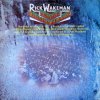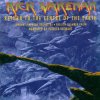Doctor Omega
Member: Rank 10

Journey to the Centre of the Earth is the second solo album from the English keyboardist Rick Wakeman, released on 3 May 1974 by A&M Records. The album is a live recording of his second of two concerts on 18 January 1974 at the Royal Festival Hall in London. With its concept based on Jules Verne's science fiction novel of the same name, the album tells the story of Professor Lidenbrok, his nephew Axel, and their guide Hans, who follow a passage to the Earth's centre originally discovered by Arne Saknussemm, an Icelandic alchemist. Wakeman performs with the London Symphony Orchestra, the English Chamber Choir, and a group of hand-picked musicians for his rock band, which later became the English Rock Ensemble. Actor David Hemmings narrates the story.
Journey to the Centre of the Earth was overall well received by music critics. It reached number one on the UK Albums Chart, the first album from A&M to do so, and peaked at number 3 on the Billboard 200 in the United States. It was certified gold by the Recording Industry Association of America in October 1974 for 500,000 copies sold in the United States. The album earned Wakeman a nomination for an Ivor Novello Award and a Grammy Award. In 1999, Wakeman released a sequel, Return to the Centre of the Earth. He re-recorded the album with additional parts previously removed from the original score due to time constraints, in 2012.


Reception
The album received some negative reaction upon its release, with music critics having described the record as a "classical pastiche...genuinely appalling" and "brutal synthesiser overkill".[23] Journey however, was well received by others. A journalist for The Sunday Times missed the Royal Festival Hall concert, but thought on record the music "comes over magnificently ... a striking work which only occasionally lapses into pretentiousness".[24] Music journalist Chris Welch of Melody Maker thought the album was "entertaining, fresh and disalarmingly unpretentious ... This could be a score for a Hollywood musical – tuneful, but with epic overtones". Welch noted Wakeman's "familiarity of the story" and his "close observance to detail engenders a warmth to the work, which made it a resounding success as a concert performance".[24] In a retrospective review, Mike DeGange of Allmusic called the album "one of progressive rock's crowning achievements" and noted "interesting conglomerations of orchestral and synthesized music".[25]
2012 re-recording
Wakeman presumed that the original conductor's score was lost when his record company A&M collapsed in the early 1980s. However, a "huge cardboard packing case" arrived at his house in 2008 which stayed in his garage for "about five months" before he found the score at the bottom which was damaged by water. A year was spent digitising and forming the complete score with conductor Guy Protheroe. Wakeman re-recorded the album with an orchestra, choir, and members of his English Rock Ensemble band as a studio album, incorporating 20 minutes that was previously cut. As Hemmings died in 2003, the narration is voiced by actor Peter Egan.[1] Released on 20 November 2012, the new album is packaged with a one-off magazine published by Classic Rock and a copy of the 1974 Royal Festival Hall concert program.
Track listing
All tracks written by Wakeman. "The Forest" includes an excerpt of In the Hall of the Mountain King by Edvard Grieg, who is credited in the album's liner notes.
Side one
- "The Journey"/"Recollection" – 21:20
- "The Battle"/"The Forest" – 18:57





